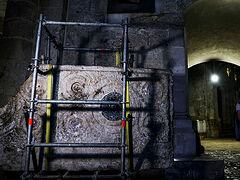Jerusalem, March 25, 2025
Archeologists in the Holy Land have uncovered yet more evidence confirming the truth of the Holy Gospels.
In 2019, the Greek Orthodox Patriarchate of Jerusalem and other communities that use the Church of the Holy Sepulchre—built over the sites where Christ was crucified, buried, and resurrected—agreed to renovations to replace the floor. At the same, they decided to allow archaeological excavations under the floor.
And the team working under Prof. Francesca Romana Stasolla of the Sapienza University of Rome has found evidence indicating that 2,000 years ago, olive trees and grapevines likely grew on the area where the Holy Sepulchre was built, reports the Times of Israel.
Archaeobotanical examination and pollen analysis of samples collected during excavations beneath the ancient basilica's floor revealed evidence of olive trees and grapevines. The archaeological context and stratigraphic positioning suggest these findings date to the pre-Christian period, though radiocarbon dating has not yet been conducted to confirm this timeline.
The Gospel According to St. John states: Now in the place where He was crucified there was a garden; and in the garden a new sepulchre, wherein was never man yet laid. There laid they Jesus therefore because of the Jews’ preparation day; for the sepulchre was nigh at hand (Jn. 19:41-42).
Given the large number of pilgrims that flock to the church every year, the archaeological team is working in the church one section at a time.
“While we have not been able to see the entire church excavated in one glance, new technologies are allowing us to reconstruct the bigger picture in our labs,” Stasolla said. “If we were talking about a puzzle, we could say we are only excavating one piece at a time, but eventually, we will have a complete multimedia reconstruction of the full picture.”
Like much of the Old City of Jerusalem, the church stands on an old quarry that eventually fell into disuse. Then the area was used for agriculture.
“Low stone walls were erected, and the space between them was filled with dirt,” said Stasolla. “The archaeobotanical findings have been especially interesting for us, in light of what is mentioned in the Gospel of John, whose information is considered written or collected by someone familiar with Jerusalem at the time. The Gospel mentions a green area between the Calvary and the tomb, and we identified these cultivated fields.”
As the quarry was progressively abandoned, tombs were also carved out of the rock, Stasolla explained.
Follow OrthoChristian on Twitter, Vkontakte, Telegram, WhatsApp, MeWe, and Gab!




